Last Updated on February 2, 2023 by Derek
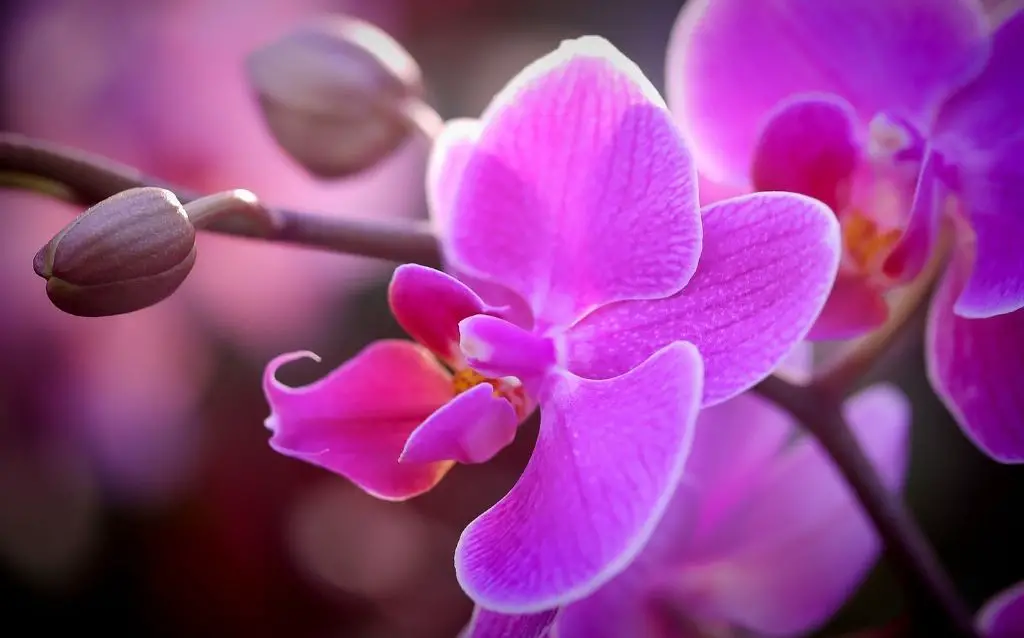
Orchids are native to the tropical rainforests, although some varieties can thrive in the desert. They are about the largest group of flowering plants globally, with over 25,000 species. Most orchid species are adapted to grow in a typical garden under the right conditions. The major types of orchids.
- Noble dendrobium orchid (Dendrobium)
- Slipper orchids (Orchidaceae)
- Cattleya
- Boat orchids (Cymbidium)
Types of Orchids with Pictures and Names
If you want to grow orchid plants in your home, you have to find the best variety suitable for your zone and climate. Below are some types of orchids with pictures.
Cattleya orchids
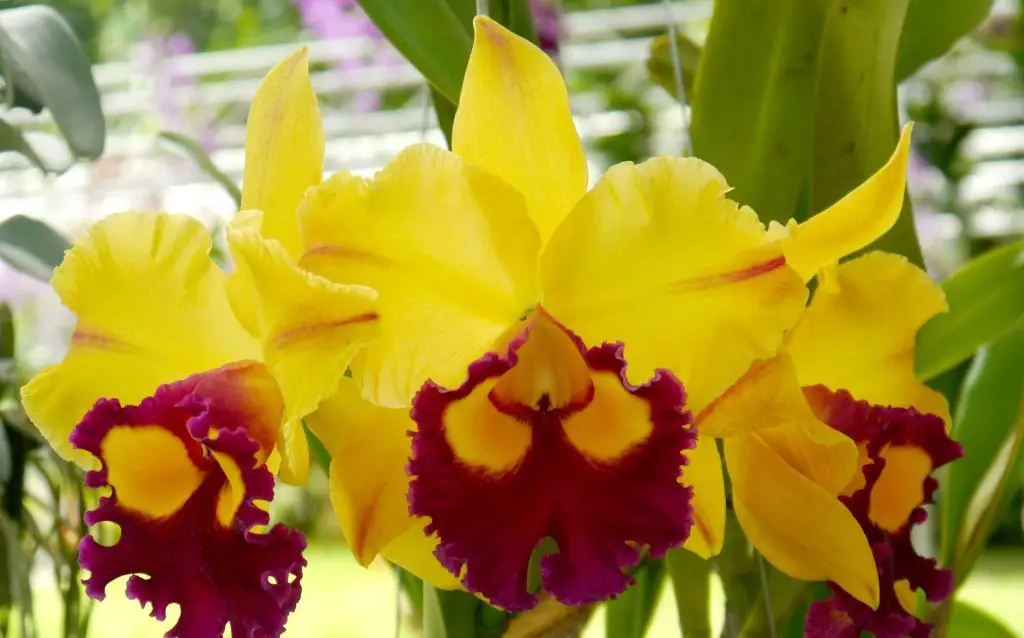
Cattleya orchids are commonly known as the queen of the orchids. They bear showy, fragrant blooms in different shades, shapes, and color combinations. Some cattleya varieties produce large flowers, while others have tiny, gorgeous ones. The flowers appear once per year, and the blooming time varies with type.
Here are some must-know facts about cattleya orchids or corsage orchids.
- It is a perennial that grows about 0.25 to 2 feet in height and width
- It thrives best in acidic commercial soilless media, particularly for orchids
- It is native to south and central America in USDA zones 10 to 12
- It flowers best in partial sun
- It flaunts all flower colors except true blue
Boat Orchids
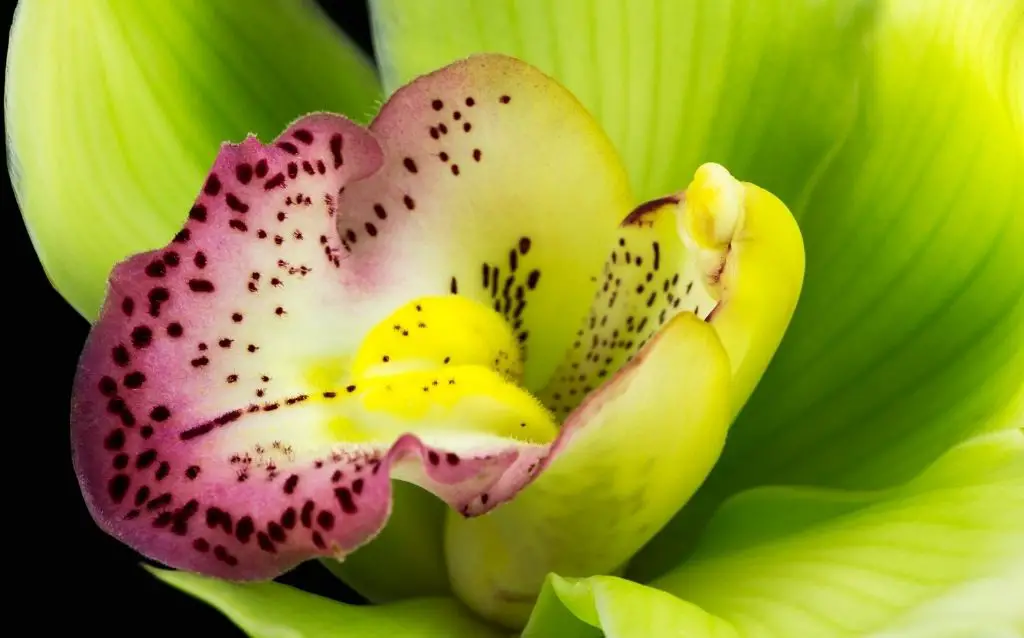
It is also called cymbidium orchids, native to Australia and Asia. Cymbidium orchids are more tolerant to cold than other orchid types. They display sprays of huge blooms in winter, and the flowers can last between one and three months. It has long, thin, attractive leaves.
- It is evergreen with a mature height of about 2 feet
- They are semi-terrestrial orchids and grow best in moist, well-draining loamy soil with 5.5 to 6.5 pH
- Cymbidium orchids grow best in zones 10 to 12
- They boast of pink, yellow, white, or green blossoms from mid-autumn to mid-spring
- Indoor cymbidiums prefer direct sunlight, but outdoor ones appreciate best partial sun exposure
Epidendrum Orchids
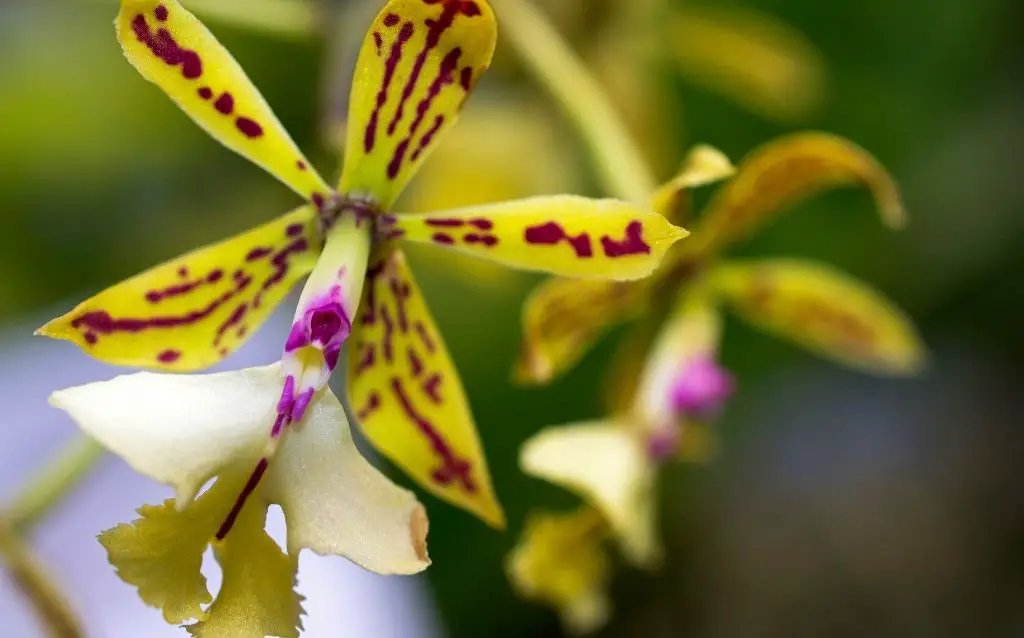
They are commonly known as reed orchids, and they live on trees (epiphytic) in their native environment. They are easy to grow in their native regions ranging from North Carolina to South America.
The reed orchid is among the most prominent genus, with over 1500 species. Some are terrestrial, while others are lithophytic, which grow on rocks. They are common in subtropical countries, including South Florida.
- They flourish in hardiness zones 10 to 11
- Their mature height is about 3 to 5 feet
- They prefer a well-draining orchid mix
- They perform best in partial sun. too little sun will cause legging of the plant hence no flowers, and too much sun will make the foliage bronze
Miltoniopsis orchid

Its common name is pansy orchid, and they are native to Panama, Costa Rica, Venezuela, Colombia, Peru, and Ecuador. They are common in rain forests and cloud forests with 1650 to 6500 feet of elevation. They have multiple stems and grey-green or pale green leaves.
- Pansy orchids do best in moist, well-draining potting mix. They require annual repotting, especially after every blooming season, for the best performance
- They grow up to 1 to 2 feet tall
- They display about 3 to 7 huge flowers 7 cm across. The blooms are flat and showy and display shades of purple, yellow, white, red, or brilliant patterns.
- They bloom throughout spring and summer
- They appreciate the partial sun
Oncidium orchids

Commonly known as the Dancing Lady Orchid, Oncidium orchid is a diverse genus with approximately 300 orchid species growing throughout tropical and subtropical America. Most of their species display blooms in fall, but some modern hybrids can bloom all year. Their flowers resemble a tiny dancer’s skirt, earning the name dancing lady orchid.
- They grow about 15 cm to 3 meters tall
- They thrive in well-drained soil and bloom in partial sun
- They love a temperature between 13 to 16 degrees Celsius at night and 26 to 30 degrees Celsius in the daytime. If humidity and air circulation rise, these plants can tolerate up to 35 to 37 degrees Celsius.
What Is the Most Common Type of Orchid?
Phalaenopsis is the most common orchid type in the market and in many gardens today. It is commonly known as the moth orchid, and it has flat, wide, and dark green leaves that grow opposite each other.
They have long stems that bear flat white blooms. The blooms can last about three months or longer. They have large petals and a smaller lip that appears horizontally under the column.
Infographic – Main types of Orchid flowers
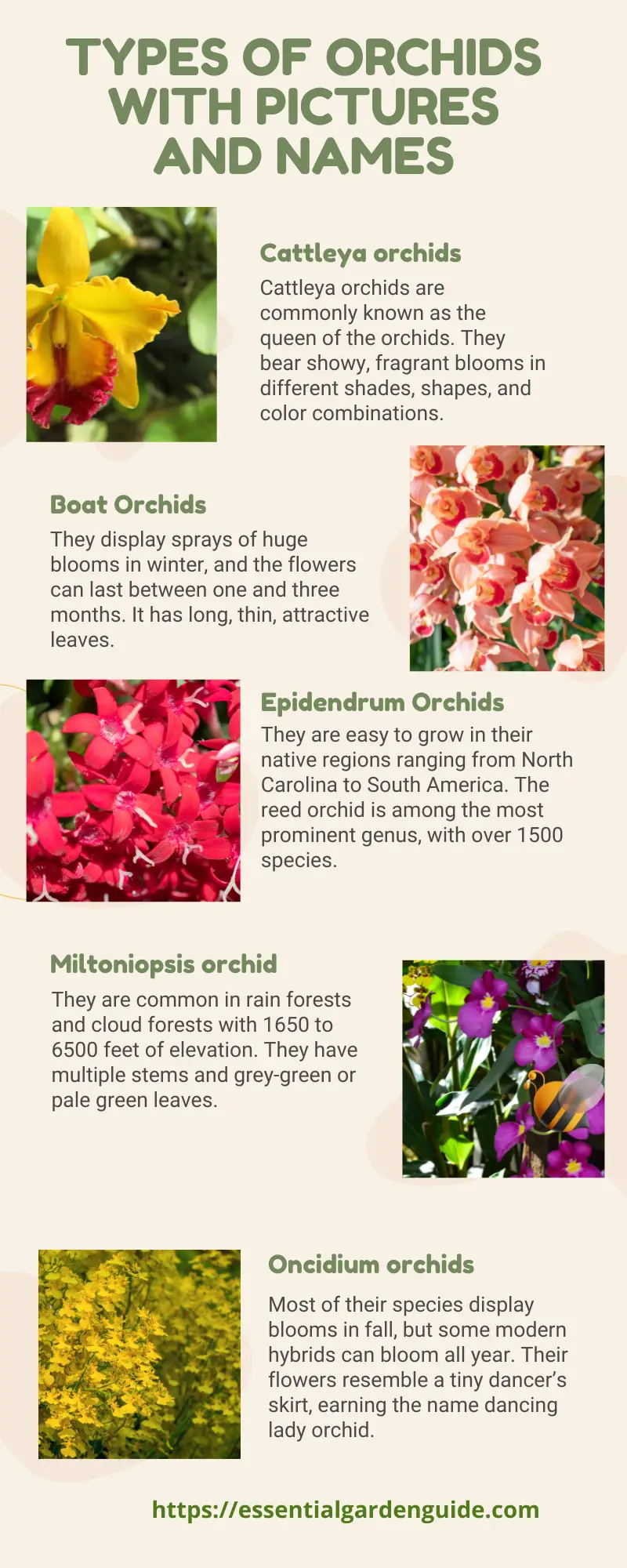
What Are the Seven Classifications of an Orchid?
Orchids are angiosperms, though they have a close relation to gymnosperms. They are also monocots, meaning they do not have secondary growth like eudicots. The following are the seven classifications of orchids.
- Domain Eukarya
- Kingdom Plantae
- Phylum Magnoliophyta
- Class Liliopsida
- Order Asparagales
- Family Orchidaceae
- Genus Dracula
Orchid Identification: The 5 Most Common Orchids for Beginners
Domain Eukarya
An orchid fit in the domain Eukarya because of its true nucleus and the membrane that binds the organelles.
Kingdom Plantae
Orchid falls under kingdom Plantae due to its ability to photosynthesize. It also has cells that process cellulose cell walls.
Phylum Magnoliophyta
Members of the phylum Magnoliophyta are flowering plants, and so is an orchid plant.
Class Liliopsida
Orchids belong to the class Liliopsida because they are monocots, meaning they possess one cotyledon. Their leaves have parallel veins, and the stems contain scattered vascular tissues. The floral parts appear in multiples of three.
Order Asparagales
An orchid plant has clusters of leaves at the base, and its flowers grow on top of the stem.
Family Orchidaceae
Members of the family Orchidaceae have a column, three sepals, and three petals.
Genus Dracula
Orchids fit into the genus Dracula because of their sinister-looking bizarre blooms.
Orchid Varieties Identification
Identifying an orchid variety requires you first to understand the plant’s anatomy. The plant’s leaves, stem, and the size and shape of the blooms can help you tell an orchid variety from another.
You can also identify wild orchids by looking at the shape, color, number of leaves, blooms, and spikes. Their natural habitats are also helpful when differentiating wild orchids.
Orchid Flowers
The plant’s flower is one of the most common ways to identify orchid species. Different varieties produce flowers in different sizes ranging from one to several inches. The flower sepals, lips, and petals also vary in type.
While most orchid varieties bear flowers in wide shades, the streaks and patterns can help tell the difference. Some colors like white are standard across all species, but some like true blue are unique. Also, consider the shapes and number of flowers per plant in your identification.
Orchid Leaves
The plant’s natural habitat has a significant influence on the shape of the leaves. For instance, dryland orchid varieties have succulent leaves to help them retain water for long.
Some orchids have round leaves while others have pointed ones. Consider also the number of leaves. Some species have a single pair of leaves, whereas others look bushy with many leaves.
Orchid Roots
The growing medium determines the type of roots for orchids. Some are terrestrial, meaning they grow in soil, and others are aerial, meaning they do not need soil since they acquire their food from the air.
How Do I Know Which Type of Orchid I Have?
Do you have an orchid you want to repot, but you do not know the type? First, look at the label or tag for the name or abbreviations. If you do not have the tag, proceed to orchid varieties identification features.
Look at the flower’s color, shape, and size. While flowers are a significant identification feature, you cannot rely on them only since many varieties display a wide array of flower shades.
If the plant is not yet blooming, you can narrow your options down to leaves and other features like Pseudobulbs. Pseudobulbs are water-storage organs, and they vary in variety. Some orchids have a pair of leaves on top, while others have leaves and bracts on along the Pseudobulbs length.
Orchid Identification Chart
Orchids belong to the Orchidaceae family, the most prominent flowering plant family. The Orchidaceae family has five subfamilies and further subdivisions to form smaller tribes. The tribes divide further into subtribes and, finally, genera. Below is a visual orchid identification chart.
| Family | Subfamily | Tribes | Examples |
| Orchidaceae | Cypripediodeae | Cypripedieae | Cypripedium and Paphiopedilum |
| Vanilloideae | Vanilleae | Vanilla orchid | |
| Pogonieae | Isotria orchids | ||
| Orchidoideae | Orchideae | Ophrys and orchis. | |
| Cranichideae | Eurystyles and prescottia orchids | ||
| Epidendroideae | Cymbidieae | Cymbidium, Catasetum, cyrtopodium orchids. | |
| Vandeae | Phalaenopsis and Dendrophylux. |
Small Orchid Varieties
Small orchid varieties, popularly known as mini orchids, have small flowers, and they never grow to the typical orchid size. Some of these miniature orchids thrive well as garden orchids, but the majority grow as wild orchids in various parts of the world. Platystele Jungermannioides is the most miniature orchid globally, with such thin blooms that you can see through them.
There are many species of miniature orchids; the following are some of them.
- Dracula orchid
- Bonnet orchids (Pleurothallis orchids)
- Luquillo Mountain babyboot orchid (Lepanthes)
- Platystele orchids
- Comet orchids (Masdevallia)









